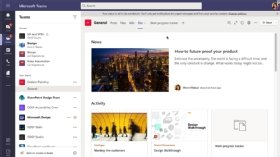
Microsoft widens Teams' reach with Dynamics 365 integration
Integration between Teams and Dynamics 365 lets sales and service reps edit customer records while talking to clients. Teams also offers integration with third-party apps.
The future of collaboration platforms goes beyond general-purpose communications. Along with providing chat, video conferencing and calling, the services are destined to become the center of workplace productivity.
The latest example of that evolution came this week at the Microsoft Inspire partner conference. Microsoft introduced integrations between Teams and Dynamics 365, the company's cloud-based business applications platform.
The product tie-in followed by seven months Salesforce's announcement that it would acquire Slack for $27.7 billion. The deal, expected to close this summer, will likely lead to tight integration between the collaboration service and Salesforce's cloud-based CRM and automation applications.
Connecting collaboration platforms with business applications makes for a more efficient workplace. For example, a sales rep or customer support person could use Teams or Slack to communicate with clients and have all their background and transaction history in front of them, without switching among multiple applications.
The ability to access and edit relevant data during a business call is what companies want from their collaboration products. A Metrigy Research survey found that nearly 60% of organizations see team collaboration software as a hub tying data sources and applications.
Companies want the integration to add "efficiency to workflow," said Bob O'Donnell, principal analyst for Technalysis Research.
Teams is well-positioned as a central access point because of the security and controls it provides to protect corporate data, said Jeremy Silber, director of innovation at Core BTS.
"Security is top of mind [among clients]," Silber said. Core BTS is an IT consultancy specializing in deploying and managing Microsoft technologies.

At Inspire, Microsoft said Teams would provide access to the rich repository of customer records in Dynamics 365, which comprises components of CRM and ERP.
As a result, salespeople and customer service reps will have that information at their fingertips during a Teams meeting. Notes taken during a Teams call are saved automatically in the timeline of the Dynamics 365 record. Notifications of the changes are sent to all the parties that have access to the documents.
People can invite each other to view and collaborate on customer accounts within a Teams chat or channel. Those meetings could be helpful in troubleshooting customer problems or tracking follow-up tasks related to additional sales opportunities.
Core BTS clients have asked the company to integrate Teams with more Microsoft products, including Exchange Online for accessing email, SharePoint for document management, and Yammer for internal social networking.
This year, Microsoft plans to let third-party software developers sell apps directly within Teams. IT admins can purchase subscriptions from the Teams admin center. Companies offering Teams apps today include Atlassian Confluence, SAP C4C, Salesforce, ServiceNow and Workday.
Over the next 12 months, Microsoft wants partners like Core BTS to focus on making Teams a competitive platform for meetings, a front end for phone systems, and the place to access applications from Microsoft and third parties. Also, Microsoft wants to sell Teams as a collaboration platform for frontline workers, such as nurses, retail sales associates and field workers.
"Dynamics is just a piece of [Microsoft's strategy]," Silber said.








